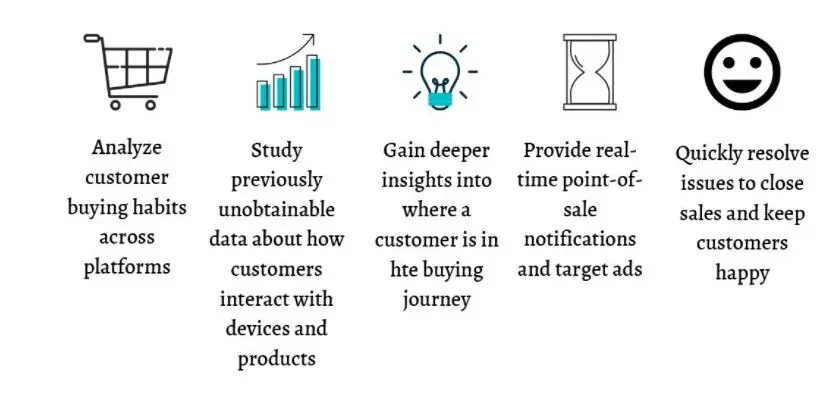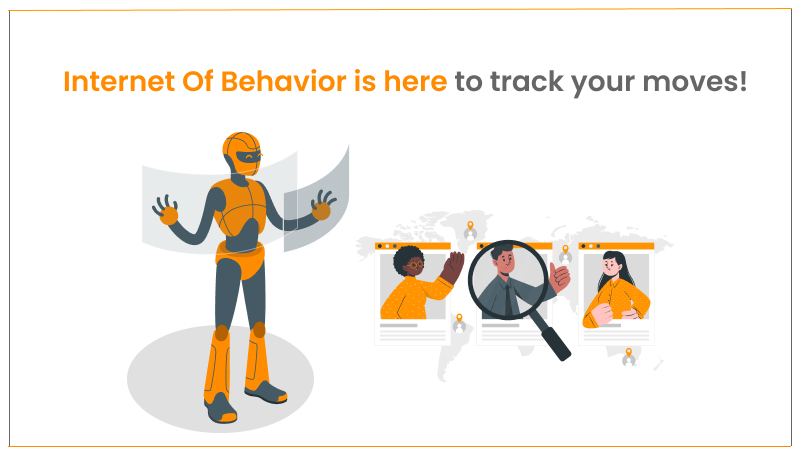“The customer rules” continues to be the ultimate mantra for businesses, be it large conglomerates or smaller ones. Analyzing consumer behavior has become an imperative function of marketing because it is important on several levels. Here, the Internet of Behavior comes in handy as it alleviates businesses to maintain their positive standing in the market.
Internet of Behavior (IoB) helps in crisis management. A thorough understanding of consumers would help the brand to tread through the crisis without much collateral damage. Thus, approaching and analyzing customer behavior has undergone significant changes with the advent of the Internet and social media marketing. This brings us to the grid of connected objects to exchange and manage data via the Internet, often called the Internet of Things (IoT).
In fact, IoB is primarily an extension of IoT; consider the pyramid below, the internet of Things helps to turn data into information, on the other hand, IoB transforms this information into valuable knowledge.

(Source: https://gbksoft.com/blog/internet-of-behaviors/)
The unification of IoT with Artificial Intelligence has paved the way for AIoT. To understand AIoT, refer to our blog!
With the help of artificial intelligence, machines are capable of tracking problems, solving them, and monitoring them for further changes. All of this is achieved using behavior & information technology within three basic steps- learning, reasoning, and perception. Internet of Things assists users, especially people involved in retail and consumer businesses, to know about the needs of their customers, which in turn has given way to a more detailed fashion of monitoring consumer needs and preferences called the Internet of Behavior (IoB).
In this article, we will delve into what IoB means and what are the advantages of behavior & information technology.
What is the Internet of Behavior (IoB)?
The Internet of Behavior collects the digital dust of people’s lives from a variety of sources, and public or private organizations can use this information to influence behavior.
– says Gartner
The definition of the Internet of Behavior (IoB) is that it attempts to deconstruct the behavioral patterns explained by the collection of data. There are multiple ways in which data is collected from consumers as psychology and marketing go hand in hand in consumer behavior and analysis.
Gartner predicts that by 2023, 40% of the world’s population (more than 3 billion) will be digitally tracked, in addition to this, by the end of 2025, a portion of more than half of the world’s population will be involved in at least one IoB program (governmental or commercial).
First and foremost, internet behavior helps brands know their target audience better than ever. Secondly, with the advent of social media, managing and monitoring a brand’s reputation has gained significance. In earlier times, maligning a brand’s reputation was not as simple and quicker as it is now. A Twitter post against the malpractices of any brand is enough to question its reputation. Thus, the satisfaction of stakeholders including customers and employees is important and requires monitoring at every step.
For example, email capture and online shopping are some of the most common ways through which marketers extract consumer information and use it to study their behaviors, preferences, and utilities. The IoB’s meaning is to enhance their customer experience and design their products accordingly. SEO and social media marketing are pillars of digital markets.
Amidst this pandemic, many businesses have switched over to social and digital media for marketing their products. Thus, all businesses are striving for online users’ attention on the search engine. Internet of Behavior (IoB) plays an important role in helping businesses enhance their online presence. For instance, by knowing what their customers are looking for, businesses can improve their discoverability by using appropriate keywords and covering popular topics.
The IoB is a combination of three fields that are interconnected with each other.

Technology is used to study behavioral science, which is divided into four major dimensions for marketers’ convenience. The four areas are:-
- Decisions
- Emotions
- Augmentations
- Championships
For instance, a mobile application specifically designed for women to keep track of their health cycle. The app releases daily alerts for adverse health conditions and suggests medical and behavior changes for positive outcomes.
Common Uses of Internet of Behavior (IoB)
We may not realize the immediate uses of internet behavior, but the IoB applications are very much a part of our lifestyles. For instance, home assistant technologies like Google Home or Alexa analyze and interpret the data to study the behavioral patterns of their users to work efficiently.
YouTube uses behavior analytics to enhance customer experience and make suitable recommendations. Social media giants such as Google and Facebook use behavioral analysis tools to understand their users and display advertisements accordingly. Thus, IoB has been around for some time now, and owing to its immense popularity, the IoB industry is set to grow exponentially.
Benefits of Internet of Behavior (IoB)

(Source: https://gbksoft.com/blog/internet-of-behaviors/)
Internet of Behavior (IoB) is still evolving, yet it benefits businesses in multiple ways. It helps business owners and marketers to know their target audience thoroughly. In this way, they engage with their customers and participate in their purchase journey, not as a salesperson but as their acquaintance.
Thus, studying internet behavior will enhance the customer experience. While discussing the Internet of behavior in length, we have touched upon its advantages including monitoring buying trends, tracking customers’ journeys, enhancing consumers’ interaction, and targeting advertisements towards a specific section of the audience among others. The following sections discuss the above-stated points in length, and they comprise key advantages of the Internet of Behavior.
1. Monitoring consumers’ buying trends across all social media platforms
In the wake of social and digital media, marketers have gotten a golden opportunity to know their customers through multiple channels. Social media platforms are one of the most engaging ways through which marketers can track customers’ changing tastes according to the seasons, age, and advent of new products.
For instance, social media platforms including Instagram and Facebook can target users through advertisements. Further, consumer behavior is assessed through “click-rates”. This feature empowers marketers to filter and release advertisements that are relevant to the users. This feature neglects all the irrelevant stuff and helps the brands connect with their consumers on a deeper level.
2. Tracking Customers’ buying journey
According to an article by Impulse Creative, Danielle Rhodes makes an elaborate note about the customer’s buying journey. The customer experience journey begins from awareness leading to consideration. Here, IoB plays a vital role in letting marketers know how much “awareness” is there among their target audience and what is needed to catch the public’s attention.
Following the awareness, marketers have to take steps that ensure customers consider buying the product/service. Yet again, marketers require the IoB online to design strategies that assure customers’ consideration for the product/service. Consideration paves the way for decisions that lead customers to the final stage of delivery.
3. Understanding customers’ interaction with products/services
Customers’ journey includes maintaining the tastes of the existing customers and making sure that they are satisfied with the interaction with products/services. Through a thorough analysis of IoB, the customers’ journey aims to maintain the customers’ trust and reward their loyalty through additional coupons and discounts to keep on making purchases and be associated with the company for a long period.
4. Providing a point of sale notifications and target ads
Using IoB, needless to say, marketers can have a clear idea of where the customer is shopping and which products/services are the most popular. With the help of the data, a grocery store owner would have a clear idea about consumer behavior towards certain products/services. Accordingly, the marketers design promotional offers and send a notification to the customers. For instance, a frequent shopper at ABC Body Works would receive emails of promotional offers on body care and home care products as opposed to someone who prefers any other body care brand.
A similar technology applies to YouTube wherein the video streaming platform recommends users based on their behavior toward other videos. Thus, IoB applications help marketers to provide real-time point-of-sale notifications and display advertisements aligned with the users’ interests and needs.
5. Resolving customer issues and ensuring that they are satisfied at the end of closing sales
Another advantage of applying behavioral & information technology is that it helps marketers maintain customer relations by resolving them quickly. Having to know your customer thoroughly enhances marketers’ strategy of maintaining consumer relations and ultimately maximizing sales. This leads us to another important function of IoB, which is, UX designing. UX designing helps marketers have a better understanding of consumers’ attitudes towards specific products and resolve their issues with a pace of urgency.
Final Words
After discussing all the significant points we can say that in easier terms, the Internet of Things is a combination of technology products connected through the Internet. This includes all those mediums that extract data and information from customers through various methods. The theoretical and scientific knowledge used to study the curated data composes the Internet of Behavior (IoB). We hope this article has helped you understand the Internet of Behavior (IoB) in-depth.







